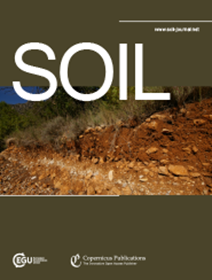What if publication bias is the rule and net carbon loss from priming the exception?
IF 4.3
2区 农林科学
Q1 SOIL SCIENCE
引用次数: 0
Abstract
Abstract. Priming effects in soil science describe the influence of labile carbon inputs on rates of microbial soil organic matter mineralisation, which can either increase (positive priming) or decrease (negative priming). While both positive and negative priming effects occur in natural ecosystems, the latter is less documented in the peer-reviewed literature and the overall impact of priming effects on the carbon balance of vegetated ecosystems remains elusive. Here, we highlight three aspects which need to be discussed to ensure (rhizosphere) priming effects are correctly perceived in their ecological context and measured at appropriate scales: (i) We emphasize the importance of evaluating net C balances because usually experimental C inputs exceed C losses meaning even positive priming doesn’t cause net C-loss; (ii) We caution against publication bias, which forces overrepresentation of positive priming effects, neglects negative or no priming, and potentially misguides conclusions about C loss; and (iii) We highlight the need to distinguish between general priming effects and rhizosphere- specific priming, which differ in their scale and driving factors, and hence require different methodological approaches. Future research should explore potential discrepancies between laboratory and field studies and examine the role of rhizosphere priming in nutrient cycling and plant nutrition.如果发表偏倚是规则,而启动导致的净碳损失是例外呢?
摘要。土壤科学中的启动效应描述了不稳定碳输入对微生物土壤有机质矿化率的影响,这种影响可以增加(正启动)或减少(负启动)。虽然自然生态系统中存在正面和负面的启动效应,但后者在同行评议的文献中较少记录,并且启动效应对植被生态系统碳平衡的总体影响仍然难以捉摸。在这里,我们强调了需要讨论的三个方面,以确保(根际)启动效应在其生态背景下被正确感知并在适当的尺度上进行测量:(i)我们强调评估净碳平衡的重要性,因为通常实验C输入超过C损失,这意味着即使是正启动也不会导致净碳损失;(ii)我们对发表偏倚提出了警告,它会强迫过度描述正启动效应,忽略负启动或无启动,并可能误导关于C损失的结论;(iii)我们强调需要区分一般启动效应和根际特异性启动效应,它们在规模和驱动因素上有所不同,因此需要不同的方法方法。未来的研究应探索实验室和实地研究之间的潜在差异,并研究根际启动在养分循环和植物营养中的作用。
本文章由计算机程序翻译,如有差异,请以英文原文为准。
求助全文
约1分钟内获得全文
求助全文
来源期刊

Soil
Agricultural and Biological Sciences-Soil Science
CiteScore
10.80
自引率
2.90%
发文量
44
审稿时长
30 weeks
期刊介绍:
SOIL is an international scientific journal dedicated to the publication and discussion of high-quality research in the field of soil system sciences.
SOIL is at the interface between the atmosphere, lithosphere, hydrosphere, and biosphere. SOIL publishes scientific research that contributes to understanding the soil system and its interaction with humans and the entire Earth system. The scope of the journal includes all topics that fall within the study of soil science as a discipline, with an emphasis on studies that integrate soil science with other sciences (hydrology, agronomy, socio-economics, health sciences, atmospheric sciences, etc.).
 求助内容:
求助内容: 应助结果提醒方式:
应助结果提醒方式:


